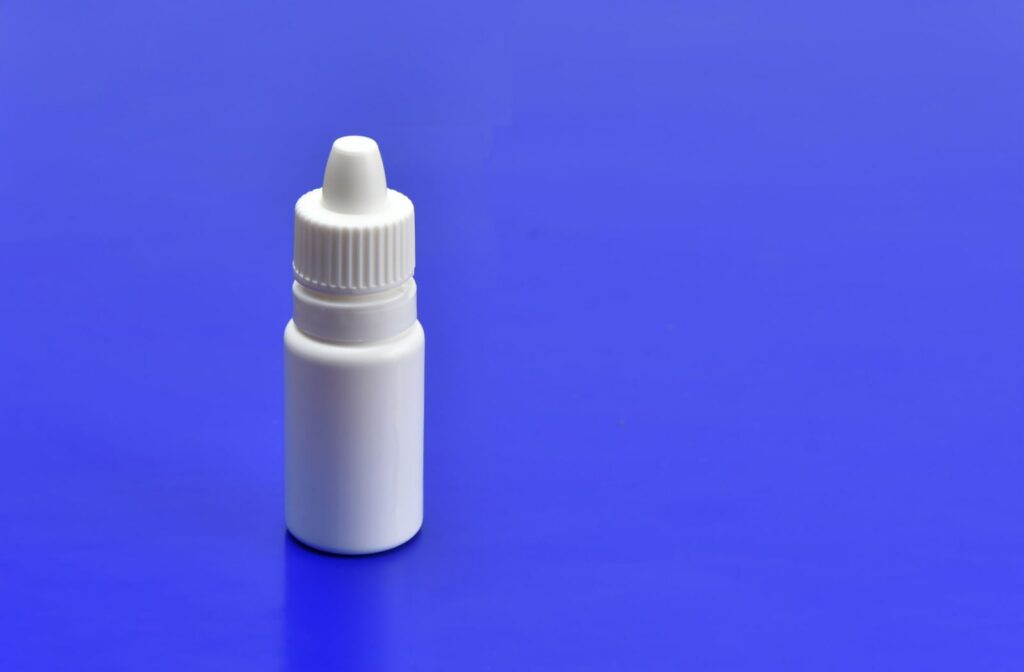Eye drops are commonly used to treat various eye conditions, including dryness, redness, itchiness, and allergies. If you experience any of these issues, your eye doctor might suggest using eye drops to help moisturize, lubricate, and reduce inflammation caused by underlying factors.
However, eye drops have expiry dates, so if you store them and forget about them until you need them again, they may not be effective. So, always keep an eye on the expiration dates of your eye drops to ensure optimal results.
What Are Eye Drops?
Eye drops are topical ophthalmic medications in liquids, gels, or ointments administered directly into the eye. You can use eye drops for different reasons, such as treating infections, allergies, glaucoma, and dry eye disease—the list goes on.
Many types of eye drops exist, each with a unique purpose and can treat symptoms like:
- Dryness
- Redness
- Itching
- Soreness
- Swelling
- Discharge
Types of Eye Drops
You can find eye drops available both with a prescription and without one, known as over-the-counter (OTC) eye drops.
Artificial Tears
Artificial tears or lubricating eye drops are OTC drops that help lubricate the eyes by adding moisture. They can provide short-term relief for dry eyes caused by digital eye strain and environmental factors, such as windy or sunny conditions.
Antibiotic Eye Drops
Antibiotic eye drops are prescription drops that treat bacterial infections, such as conjunctivitis (pink eye). Your eye doctor will prescribe eye drops depending on the type of pink eye or infection.
Glaucoma Eye Drops
Glaucoma eye drops reduce internal eye pressure (intraocular pressure) by helping drain or decrease the fluid your eyes produce. If untreated, glaucoma can lead to vision loss.
Antihistamine Eye Drops
Antihistamine eye drops reduce allergy-related symptoms like itchiness, redness, watery eyes, or swelling. These drops reduce the histamines your body produces in response to an allergen.
Decongestant Eye Drops
Decongestant eye drops, also called whitening eye drops, reduce redness in the eyes. These drops contain vasoconstrictors that shrink the tiny blood vessels in the whites of the eyes, making them look less red.
If you use decongestant drops too often, you can become tolerant to their effects, resulting in rebound redness (more redness) when the drops wear off.
Dilating Eye Drops
Your eye doctor may use dilating eye drops during a routine eye exam to open your pupils to better look at the back of the eyes for signs of eye issues or eye diseases.
Eye Drops Have Expiry Dates
Like any other medication or pharmaceutical product, eye drops have expiry dates. These dates are printed on the bottle or box and indicate how long the eye drops will remain safe and effective when stored under ideal conditions.
Once a bottle of eye drops is opened, it becomes exposed to air and potential contaminants, which can lead to a risk of bacterial growth or degradation of the formula over time. While preservatives can help slow down the growth of bacteria, fungi, and viruses, even eye drops with preservatives have a shorter shelf life after opening them. When you break the seal and use a bottle of eye drops for the first time, ensure you’re ready to use them.
Using expired eye drops can be risky as they may not be as effective or could be contaminated, leading to adverse reactions in your eyes. Expired eye drops with preservatives may degrade and cause infections or other problems.
So, be mindful of the expiration dates on your eye drops and avoid using them past their expiry date to ensure your safety and optimal results.
How Long Are Eye Drops Good For?
Before they’re opened, both preservative and preservative-free eye drops typically have a relatively long shelf life, and they’ll be good as long as their expiration date hasn’t passed. Depending on the brand and formulation, this can range from 1–3 years.
The shelf life can vary once a bottle of eye drops is opened. Preservative-free eye drops usually have a shorter lifespan after opening, typically around 24 hours, because they don’t contain preservatives to inhibit bacterial growth.
Eye drops that contain preservatives generally have a longer lifespan after opening, around 1–3 months, depending on the specific product.
Using expired eye drops can lead to reduced effectiveness, potential contamination, and increase the risk of eye irritation or infection. Symptoms of eye infections include:
- Eye pain
- A foreign body sensation
- Increased sensitivity to light
- Yellow, green, bloody, or watery discharge
- Red eyes or eyelids
- Fever with no other cause
- Blurry or decreased vision
How to Safely Use Eye Drops
13 to 40% of people have difficulty using eye drops properly. Here are some tips:
- Wash your hands thoroughly to avoid transferring bacteria or other germs to your eyes.
- Shake the bottle gently, if recommended, before opening it.
- Avoid touching the tip of the dropper to your eyes, eyelids, or any other surfaces that can contaminate it.
- Do not administer more drops than required or recommended.
- To avoid missing the surface of the eye, tilt your head back slightly and use your finger to pull the lower eyelid down gently. Place the recommended number of drops inside your lower eyelid while looking up. Close your eyes for a few moments to allow the drops to be absorbed completely.
When to See Your Eye Doctor
Although eye drops can help provide relief, some conditions require medical attention. If you experience any severe or persistent symptoms, such as eye pain, severe itching, or sudden blurry vision, visit your eye doctor to determine the cause.
Our Total Focus Optometry team is here to help. Book an appointment with us to determine the cause and discuss the best practices for using eye drops.



